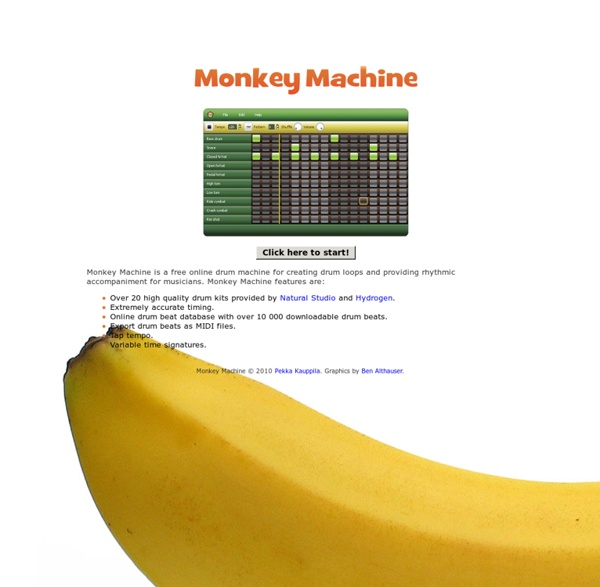



http://www.rinki.net/pekka/monkey/#
Related: MusicTen of the best music apps for kids From hammering saucepans to bellowing Justin Bieber in the bath, many children love to make a musical racket. Inevitably, there are apps for that too. A range of developers have been finding inventive ways for children to explore creative music-making – or the world of music more generally – on tablets and smartphones. Sound Chopper 2 V2.0 Sound chopper 2 is a stand alone application built in Max/MSP. Sound Chopper 2 features a granulator, stretcher, pitch shifter, slicer and tremolo, panner, bit crusher, 8 different delays (mono and stereo) and 8 filters. Those parameters can also be automated over time so you won’t need to touch 20 knobs all at once. All the parameters are midi compatible, also you can use your webcam as an xy pad, just grab a blue object and the software will track the position, also if you own a motion leap controller you can map the values to the position of your hand. Inside the software you’ll find a pdf (under “Option” – “Let’s get started”) that explains it in more details.
Neil Young’s online music archive is here, and it’s fucking incredible If ever there was a time to listen to Neil Young, it’s today. The musician’s entire catalog is available to stream for free on his newly launched archival website. “We developed [the archive] to provide fans and historians with unprecedented access to all of my music and my entire archive in one convenient location,” writes Young in an open letter introducing the archive. The songs are organized chronologically spanning more than 50 years. Included are all of Young’s released solo titles, as well as his records made with Buffalo Springfield, Crosby Stills Nash and Young, and Crazy Horse.
Making music in Linux and beyond You can do a lot with free open-source software, also known as FOSS. Musicians with a yen for Linux are in luck; the array of choices for creating, editing, producing, and publishing music using nothing but FOSS software is staggering. One way to get your hands on a plethora of audio tools is to run the Ubuntu Studio distro, which comes preconfigured for real-time audio processing and includes every studio tool under the sun. Failing that, there are the ubuntustudio-audio and ubuntustudio-audio-plugins virtual packages in Ubuntu, which will install 54 and 18 specialized packages, respectively. Other alternatives include the Musix distribution and the low-end hardware distro dyne:bolic, but Ubuntu Studio has the largest toolkit in the genre and enjoys the widest support as well. Pick your favorite multimedia distro and go nuts, or just install the applications you want to try out, one RPM or DEB package at a time.
Applying Maker Education to Music Bharti, P. (2014, November 1). Why is the maker movement important? [Web page]. Retrieved from Bransford, J.D., Brown , A.L., & Cocking, R.R. (Eds.). (2000). How people learn: Brain, mind, experience, and school. Recording in Ubuntu Linux (aka Free and Open Source Digital Audio Workstation) Editors Most of these toolbar buttons should be familiar to anyone that uses multitrack and sequencing programs, but the editors deserve a little extra explanation. Editors The matrix and percussion editors are your standard sequencer style editors. Rosegarden also has a standard, western music notation editor that you can print to pdf or postscript. In the event editor you can go into finer control of MIDI data as well as add indicators, clef/key/tempo changes and a few other things I don't understand yet!
Tinkertunes This page is currently under construction, but you can see video of all of our instruments on our YouTube Channel . Kinderbells the Musical Flower Garden, was an entry in the 2013 ArtPrize in Grand Rapids, Michigan. The eight brightly colored bells, tuned to a G Major diatonic scale, are made from the tops of condemned oxygen tanks, and are played by shaking rope handles which are attached to golf balls. The Garden Club of Cadillac, Michigan has received a grant to purchase this piece, and it will be installed this spring in that city’s sound garden In 2012, our first ArtPrize entry, The JunkYard Music Box finished in the top 50 of over 1500 art works. This human powered, automated musical sculpture was made entirely of recycled material, and attracted huge crowds. Making Music(Beats) on Linux/Ubuntu with Hydrogen I am going to review a couple of Music Making Softwares for Linux and am starting with the simplest and one of the best!HYDROGEN. Hydrogen basically is a pattern based drum programming software which in layman terms means, it allows you to make your own beats.And in case you aren't much into music, you might be wondering “what the hell will i do with this piece of software”...well here is a word from my friends who've tried this: “Its pretty fun playing with this software, n even without knowing much, you could actually MAKE SUM MUSIC!!!” About the software:(technical:from the software's website itself!)
ButtonBeats Virtual Guitar Beatles - Here comes the sun [#U@c]Un$U$nU[bvcPE]U[bn]U[bv!x]#b#U[n#] [U@c]$Un$Un$U[bvcPE]$nU[#v!x] [U@c]$n$U$Un$[bvcPE]$n$[U*cP0] [U@c]$nU @LUn@UnvUn@UnU#b@ [#U@c]Un$U$nU[bvcPE]U[bn]U[bv!x]#b#U[n#] [U@c]$Un$Un$U[bvcPE]$nU[#v!x] [U@c]$n$U$Un$[bvcPE]$n$[U*cP0] [U@c]$nU @LUn@UnvUn@UnU#b@ [U@c]$Uv@[bv! Learn Mastering Technique in Free Videos: Limiting, M/S, Dubstep Bass Mastering to me is a bit like applying stain to wood: done correctly, it brings out the definition of what’s there rather than covering it up. But making mastering effective is a really special art. Danny Wyatt, a veteran mastering engineer now working as an instructor with Dubspot, has some serious credentials both on the mixing and mastering side and as an educator. He’s worked with a range of artists over the years (Wax Poetic featuring Norah Jones, Curtis Mayfield, Thievery Corp., the Roots, Ultra Records, and Mos Def, to name a few). But he also doesn’t mystify his knowledge: he’ll tell you straight what he believes, both face-to-face and as a teacher. I feel I know Danny’s work a whole lot better, too, having had him master my new solo electronic album, which will be released soon.